The warm spring breeze brings the sound of birds chirping, signaling nesting season. Finding a bird’s nest in an unwanted spot can be tricky. Moving a nest with eggs is complex and often illegal. It’s important to know the laws and best ways to do it to protect the birds and avoid fines.
Key Takeaways
- Moving a bird’s nest at the wrong time could result in breaking the law as nests are protected under the Wildlife & Countryside Act 1981.
- There are strict legal guidelines and penalties for disturbing nests, eggs, or young birds.
- Only certain non-native bird species, like house sparrows and European starlings, are not protected under these laws.
- Seeking guidance from wildlife authorities is recommended before attempting to relocate a bird’s nest.
- Proper handling techniques and sanitization are crucial when moving a nest to minimize risks and ensure the safety of the birds.
Identifying Bird Eggs and Nest Locations
First, it’s key to figure out the bird type and its eggs. Eggs come in many colors and sizes, based on the bird. Common places for nests near homes are eaves, gutters, porch beams, bushes, and trees. Watching the nest and its area helps decide what to do next.
Learn to Identify Bird Eggs by Color and Size
Bird eggs vary a lot in size, from tiny hummingbird eggs to big robin eggs. Their shapes can be different too, like not being round like chicken eggs. The eggs’ texture can also change, with various surfaces.
Egg color is key for telling them apart. Eggs can be white, brown, or beige, with different patterns. Look for spots, speckles, and splotches in various colors to identify them.
Common Nesting Spots Around Homes
- Eaves
- Gutters
- Porch beams
- Bushes
- Trees
Looking at the nest and its area gives clues about the bird and what to do. Knowing about bird eggs and where they nest is key for handling nests right.
“Moving a bird nest is usually not an option due to legal restrictions; the Migratory Bird Treaty Act protects birds, nests, and eggs, making it illegal to disturb them.”
Learning about bird eggs and where they nest helps you handle nests responsibly and legally. This way, you won’t disturb these protected birds.
Identifying bird eggsand understandingbird nesting locationsare key steps in handling a bird’s nest right. Watching the nest and its area gives insights into where they nest, helping you act wisely.
Observing Nesting Birds Responsibly
Seeing nesting birds up close can be amazing. But, we must watch them without disturbing their homes. By being careful, we can learn a lot and help with important science projects.
Enjoy the Front-Row Seat Without Disturbing the Birds
Some bird nests are easy to see. This lets us watch their behavior closely. But, we should stay back and not move suddenly. It’s best to watch for just a minute and in the afternoon when birds are usually done laying eggs.
Don’t watch during the first few days of incubation or when the young birds are almost ready to fly. Also, wait until morning or evening to avoid scaring the birds.
Collecting Data for Citizen Science Projects
- Watching and recording bird nests helps us learn more about them. This information is crucial for conservation.
- Projects like NestWatch let people track and share their findings on local bird nests.
- This data helps scientists understand bird populations and how they nest. It also shows what affects their success.
Watching birds responsibly lets us enjoy their beauty and help protect them. By not disturbing them and joining science projects, we can make a big difference for these amazing birds.
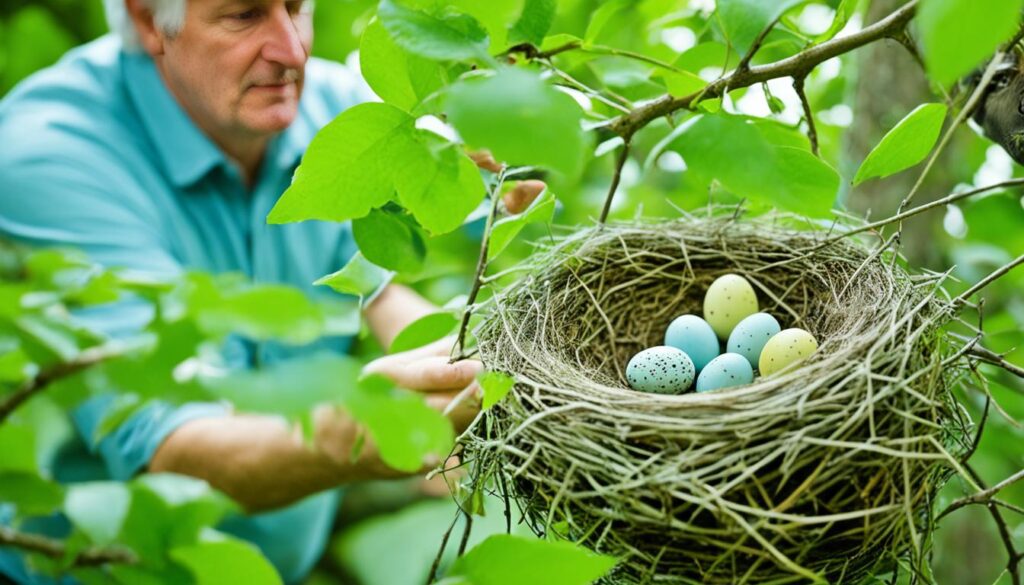
“The most important thing is to try and inspire people so that they can learn to think for themselves. Cause it has always been my contention that as long as you teach a man to question and to learn to think for himself, he’ll find his way through to what he needs to know.” – Aaron Swartz
Legal Considerations for Moving Bird Nests
Finding a bird’s nest on your property can be exciting, but it also brings legal issues. The Migratory Bird Treaty Act, a federal law in the U.S., protects most birds, their nests, and eggs. It’s illegal to disturb or move an active bird nest, even if it’s in a hard spot.
Understanding the Migratory Bird Treaty Act
The Migratory Bird Treaty Act (MBTA) covers over 1,000 bird species in the U.S. It makes it illegal to harm or move migratory birds, their nests, or eggs without permission. Breaking this law can lead to fines from $15,000 to $250,000.
About 80% of bird species leave their nests if moved, putting their young at risk. So, it’s key to call wildlife experts before moving nests to follow the law and protect the birds.
“Constructing birdhouses and feeders in gardens can create optimal habitats for birds and prevent the need for nest relocations.”
Other laws like the Bald and Golden Eagle Protection Act and the Endangered Species Act might also apply. State and tribal laws may add more rules on handling bird nests. Always check the laws in your area before taking any action.
How to relocate a bird’s nest with eggs?
Moving a bird’s nest with eggs is a tricky task. It’s best done with help from wildlife experts. Trying it alone can cause the eggs to be left behind and the nest to fail. If you must move a nest, do it carefully to protect the eggs and the baby birds.
In the U.S., it’s against the law to touch any active nest of a native bird. Also, nests found in spring might still be visited by young birds for a few days before they leave. When moving a nest, pick a new spot close by but safe. Always wear gloves to avoid getting mites, bacteria, or parasites.
Mama birds might not come back to the nest if they see humans around. After moving a nest, clean the area well. Put the nest in a bag and keep it away from pets or other animals. The nest materials will break down or be used by other birds.
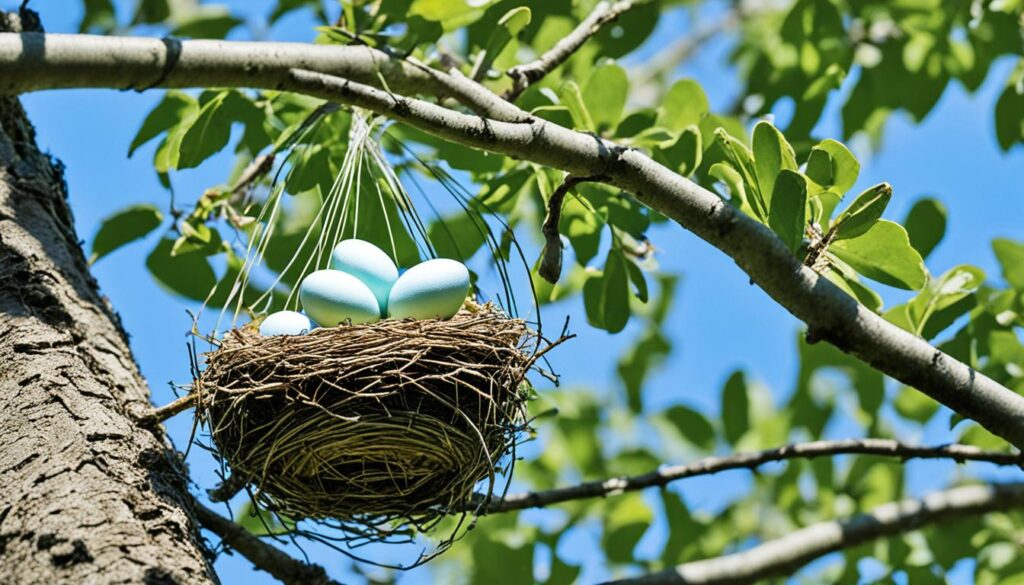
To stop birds from nesting in the same spot again, clear the area or add a sloped roof. About 90% of bird nests with eggs are active during nesting season. Adult birds use a nest for about a month after the eggs hatch.
The federal Migratory Bird Treaty Act of 1918 in the U.S. stops people from disturbing bird nests. Similar laws are in place in the U.K. and Canada. Always get advice from wildlife experts before moving a bird’s nest with eggs.
Avoiding Nest Disturbance During Nesting Season
During the nesting season, it’s important to watch out for birds near your home or workplace. Most songbird nests last about 30 days, from when the eggs are laid to when the young birds leave the nest. Keeping quiet during this time helps the birds have a successful breeding cycle.
Adjusting Your Routine to Minimize Disturbance
To avoid disturbing a bird’s nest, change your routine and use a different door or path. Try to visit nests for less than a minute. It’s best to check nests every 3-4 days, following the NestWatch rules.
Stay away from nests early in the morning, the first few days of incubation, during bad weather, at dusk, or when young birds are almost ready to leave the nest. Also, be careful of nest predators like cats, crows, and jays. Try not to walk near nest sites to avoid making it easier for them to find the nest.
Always ask the landowners before looking for nests on private land. This is important for your safety and theirs.
Remember, disturbing an active nest or its contents is illegal in the U.S. and Canada without the right permits. By following these rules and changing your routine, you can help local bird populations during the nesting season.
When Relocation is Necessary
Sometimes, moving a bird’s nest is needed, like when it’s a safety risk or in a busy area. But, always get wildlife authorities’ okay first. They can tell if moving is right and how to do it safely.
Contacting Wildlife Authorities for Assistance
Moving a bird’s nest without permission can be illegal, especially for protected birds. Laws vary by place, but in North America, the Migratory Bird Treaty Act of 1918 has strict rules. Before moving a bird’s nest, always contact your local wildlife authorities for help. They can check the situation and tell you the best thing to do, keeping birds and people safe.
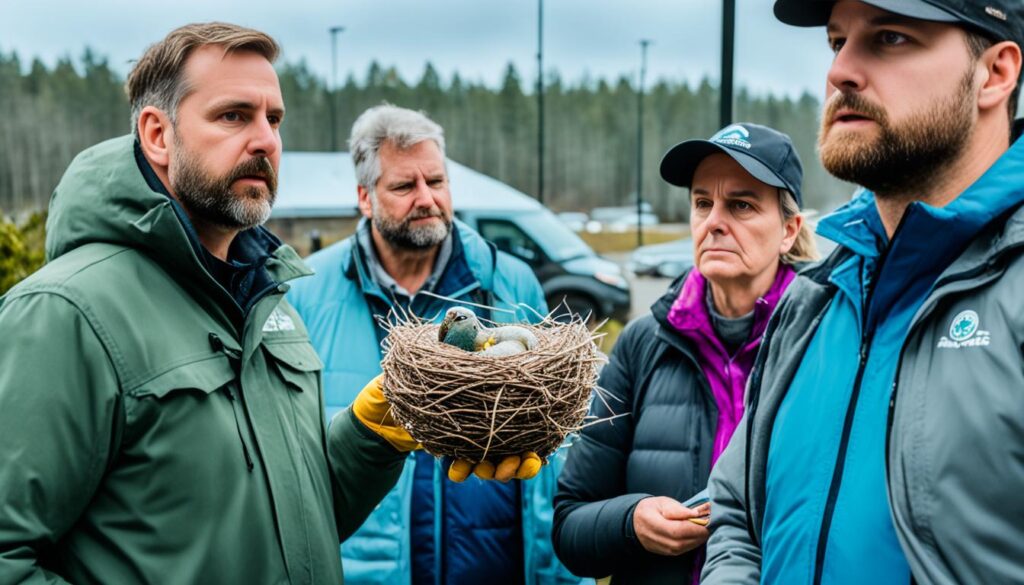
“Moving a bird nest that has eggs or baby birds in it is a meticulous and sensitive job. It’s best to leave it to the professionals.”
The nesting season is usually two to three months long. Birds are very vulnerable then, and their eggs or young need protection. Relocating a bird’s nest during this time can be dangerous and might cause the birds to leave or hurt the eggs or chicks. Wildlife experts can give advice on when and how to move the nest to lessen harm to the birds.
By contacting wildlife authorities when you think you need to relocate a bird’s nest, you help keep the birds safe. You also follow the law and rules where you live.
Protecting Bird Eggs During Relocation
When moving a bird’s nest, it’s key to handle the eggs carefully to avoid the parents leaving them. Keep the eggs warm and move them fast to a new spot close to the old one. Watching the nest after moving is also crucial to make sure the parents keep caring for the eggs.
Minimizing the Risk of Abandonment
To keep bird eggs safe and stop the parents from leaving, follow these steps:
- Move the eggs gently and fast, without touching them too much.
- Keep them warm in a box or with a low heating pad.
- Put the nest back near where it was to help the parents find it again.
- Watch the nest from afar to see if the parents are still looking after the eggs.
- If you’re not sure what to do, ask local wildlife experts or conservation groups for help.
Keeping bird eggs safe and stopping them from being left behind is key for the eggs to hatch and the chicks to survive.
“The Migratory Bird Treaty Act of 1918 protects many bird species. Laws stop people from destroying or moving nests, making it illegal in most cases.”
Safe Nest Transfer Techniques
Moving a bird’s nest needs special care to keep eggs and young safe. Safe nest transfer techniques focus on keeping the nest and its contents safe. This means causing little disturbance and protecting the nest.
First, know the laws about relocating bird nests. In the U.S., it’s often illegal to touch nests of native birds because they’re protected by the Migratory Bird Treaty Act. But, nests of birds like house sparrows or European starlings are okay to move.
- Find a safe spot near the original nest for the move, making sure it’s protected and close by.
- Use protective gear, like gloves, to avoid getting sick from the nest.
- Take the nest out carefully without harming the eggs or young inside.
- Put the nest in a safe box or basket and move it to the new spot.
- Clean the old nest area well to stop birds from coming back there.
Even with careful steps, mama birds might leave the nest after moving it. So, watch the nest closely and get help from wildlife experts if needed.
“Putting nests in a tied bag and moving them away from pets is a good idea to keep the eggs and young safe.”
There are ways to stop birds from rebuilding in the same spot. You can clear the area, add a sloped roof, or remove their hiding spots. By using safe nest transfer techniques, you can help birds and reduce the effect on their nests.
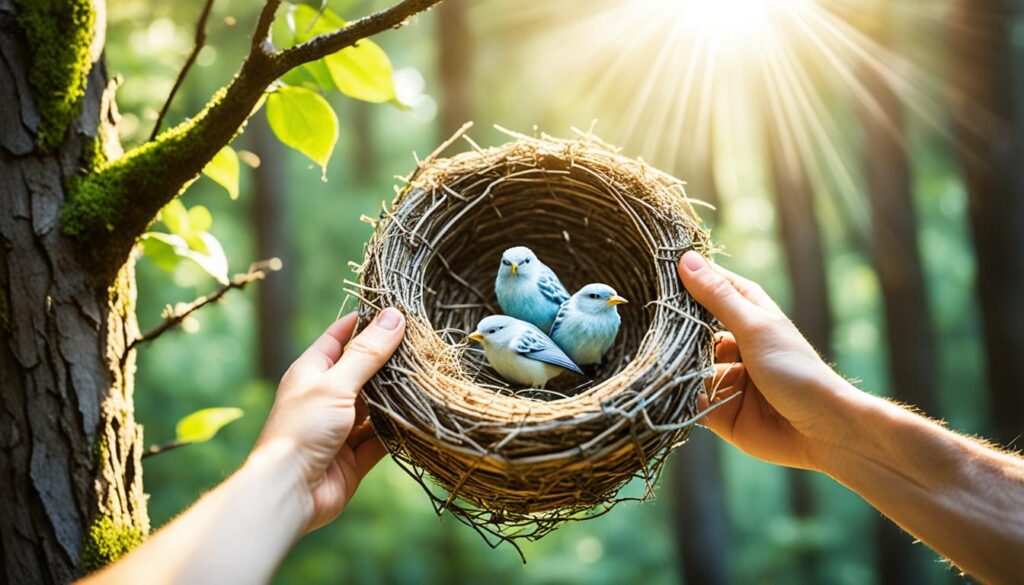
Avian Nesting Guidelines and Best Practices
Looking after our feathered friends means following avian nesting guidelines and best practices for bird nests. These rules are key for the birds’ health and their babies. They also help us take care of the environment.
It’s important not to disturb active nests. Stay away from nesting sites, especially when birds are breeding. Also, use fewer pesticides and chemicals to protect the birds and their homes.
- Permit requirements for purposeful take of an active migratory bird nest: Permit required.
- Permit requirements for relocating an active bird nest: Permit always required.
- Types of authorizations available for bird nests: Birds in Buildings Regulatory Authorization, Good Samaritan Provision, Depredation Permits, Utility Permits, Scientific Collecting Permits.
Helping local birds by offering them places to nest or food can be very helpful. By sticking to avian nesting guidelines and best practices for bird nests, we can live in harmony with birds. This helps the whole ecosystem stay healthy and strong.
“The greatest threat to our planet is the belief that someone else will save it.” – Robert Swan
Wildlife Conservation and Ethical Nest Removal
Moving a bird’s nest should be a last choice, as it can harm wildlife conservation efforts and the ecosystem. It’s key to choose ethical ways that don’t hurt the birds or their nests.
The Migratory Bird Treaty Act (MBTA) says it’s illegal to destroy a nest with eggs or chicks, except in rare cases. You need a special permit to remove a nest if it’s a health or safety risk, or if the birds are in danger. Destroying nests can hurt many birds because they are easily disturbed.
Some nests, like those on the ground or in tree holes, are hard to spot and can be destroyed by mistake. Nests of bald and golden eagles are always protected and need a permit to be destroyed.
- Permits for moving bird nests are rarely given by the U.S. Fish and Wildlife Service and State authorities.
- The Migratory Bird Treaty Act makes it illegal to disturb native bird nests without a permit, with few exceptions.
- It is illegal to have live or dead non-game native birds, their feathers, nests, or eggs without a permit.
Before taking any ethical nest removal steps, talk to local wildlife experts and conservation groups. This ensures you follow the law and find ways that help the birds and their homes.
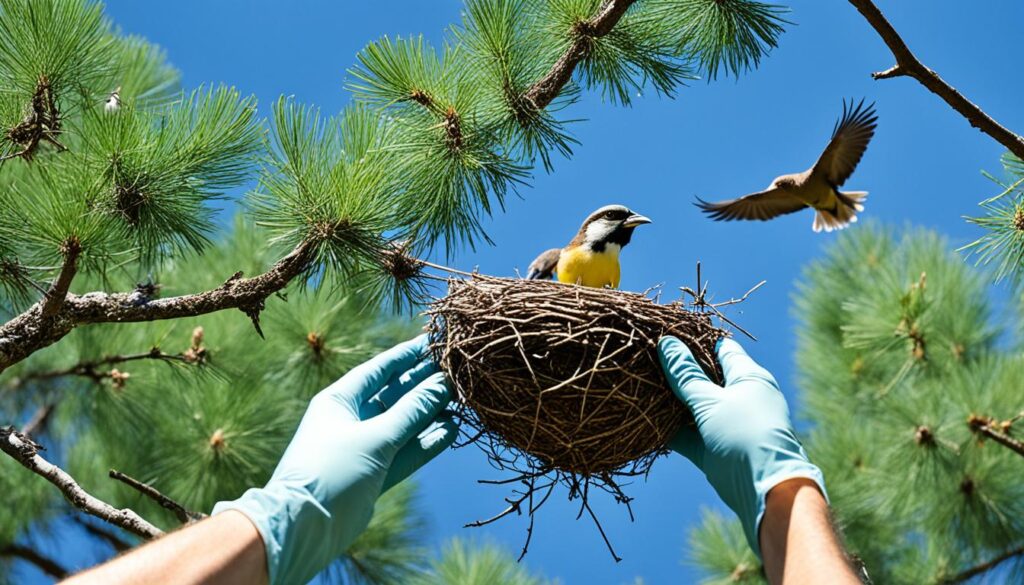
“Protecting our native bird populations and their habitats is not just a legal requirement, but a moral obligation to ensure the health and balance of our local ecosystems.”
Egg Incubation During Relocation
When a bird’s nest needs to be moved, the eggs inside must be handled with care. Proper egg incubation and egg care during relocation are key. They help the nest move safely and keep the developing hatchlings healthy.
Moving a nest with eggs is tricky. Small changes can make the parents leave the nest. To avoid this, the eggs must stay warm and safe. This might mean using portable egg incubators to keep the right temperature and humidity.
It’s important to watch the parents during the move. Seeing how they act can tell us if they like the new nest and will keep caring for the eggs. If they seem upset or stop coming, we might need to act fast to save the eggs.
“Moving a robin’s nest will likely result in the parents abandoning the nest, eggs, and/or young. Nest-site fidelity increases throughout the nesting season, leading to a reluctance to abandon disturbed nests.”
Sometimes, moving a nest means taking the eggs out for artificial incubation. This should only be done by experts. The right conditions for incubation vary a lot by species.
Putting the eggs’ care first during relocation helps the nest move well and the hatchlings grow. Following best practices and working with wildlife experts ensures the move is safe and right.
Nest Box Installation for Relocated Nests
When you move a bird’s nest, you might need to use a nest box or artificial nest. This helps the eggs and baby birds feel safe and secure. Make sure to follow advice from wildlife experts when putting up the nest box.
The National Wildlife Federation says a nest box is key for a healthy outdoor space. More development and removing natural nests means birds have fewer places to nest. A good nest box can be a big help for these birds.
There are many types of bird nesting boxes for different birds. Think about the material (like pine, cedar, or fir), wall thickness, hole size, roof style, drainage, and ventilation. Where you put the box is also important, as it affects which birds will use it.
For a safe and successful nest, follow best practices for installing the box. Put it on a tree or pole with guards against predators. Don’t put it facing west, and set it up early, usually from late February to mid-March.
Watch the nest box during breeding season and clean it regularly. This helps native birds use the box and keeps away pests. Also, remove invasive nests to make room for native ones. Quickly cleaning out abandoned nests lets you have more broods in one season.
“The optimal time to set up a nesting box is before the breeding season starts, typically between late February in the south to mid-March in northern regions.”
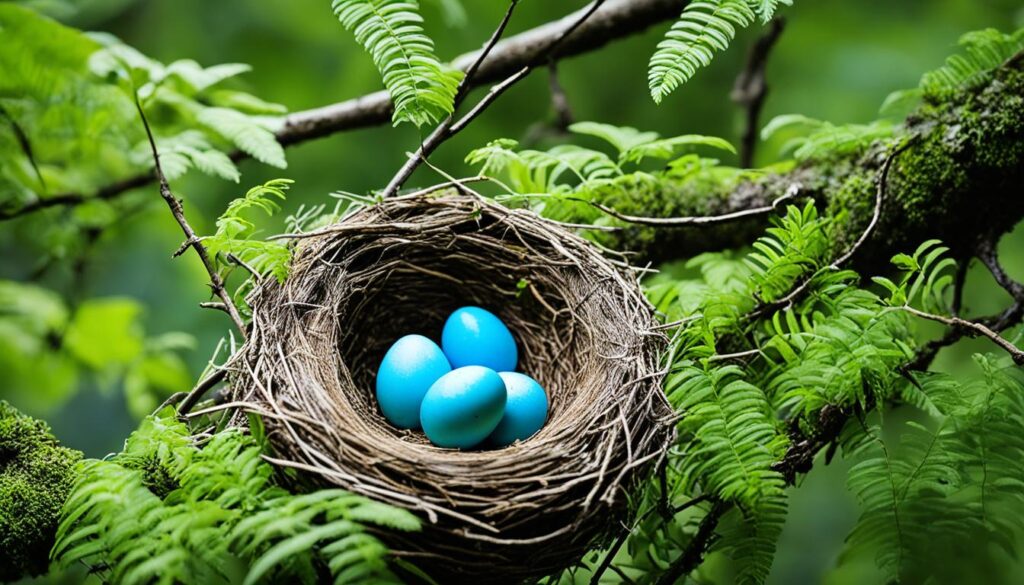
By following these tips for nest box installation, you can give the moved birds a safe home. This helps them succeed and supports the local bird population.
Bird-Friendly Landscaping to Attract Nesting Birds
Creating a bird-friendly landscape around your home helps support local bird populations. It also reduces the need for nest relocation. By using native plants, offering water, and installing birdhouses, you can make your property a haven for nesting birds.
Research shows that planting with birds in mind attracts them in greater numbers with more variety and longer visits. Growing plants that serve as nesting sites and food sources makes birds feel at home. Planting shrubs in groups of three or more creates larger areas of cover. Thorny shrubs like roses or flowering quince provide secure nesting places for various bird species.
Native trees and shrubs, such as flowering crabapples, hawthorns, junipers, and pines, attract birds. Spring-flowering trees like crabapples draw in birds during migration, as they seek out insects. Berry bushes are irresistible to birds like bluebirds, thrashers, and catbirds.
Providing cover through a variety of plants protects birds from predators and offers them safety. Avoiding pesticides and maintaining a natural look in the garden by allowing plants to knit together and leaving dead leaves as mulch attracts a wider variety of bird species for food and shelter.
By embracing bird-friendly landscaping, you can enhance your outdoor space’s beauty. You also play a meaningful role in supporting local bird populations and contributing to wildlife conservation efforts.
Conclusion
Moving a bird’s nest with eggs is a tricky task that needs help from wildlife experts. It might seem good to move a nest that’s in a bad spot, but we must think about the laws and the safety of the birds. By being careful and making places bird-friendly, we can live with these birds and help protect them.
Arctic Terns use the earth’s magnetism, stars, and sun to find their way back home. They can even find their nests if they’re moved far away. But moving a nest with eggs gets harder as the eggs get older. New eggs have a 95% chance of making it, but by day 10, that drops to just 10%.
It’s best to leave bird nests alone, especially from March to late August. By respecting their homes and ways, we help them survive and keep our bird populations healthy. With careful planning and a love for wildlife, we can live with birds without often needing to move their nests.
FAQ
How do I properly relocate a bird’s nest with eggs?
Moving a bird’s nest with eggs is a tricky task. It’s best done with help from wildlife experts. Trying it yourself might make the birds leave the eggs behind, causing the nest to fail.
How can I identify different types of bird eggs and nest locations?
Bird eggs come in many colors and sizes, depending on the bird type. Common places for nests near homes include eaves, gutters, and trees. Watching the nest and its area can help you figure out what to do next.
How can I observe nesting birds responsibly?
If a bird nest is easy to see, you can watch the birds up close. But be careful not to scare them away. Watching from afar and keeping a record of what you see helps with bird conservation.
What are the legal considerations for moving a bird’s nest?
The Migratory Bird Treaty Act protects many bird species and their nests. Moving an active nest is usually illegal. Always talk to wildlife experts before moving a nest to know what’s right and legal.
When is it necessary to relocate a bird’s nest?
Moving a bird’s nest should be the last option. It can harm local birds and nature. If you must move it, get wildlife experts’ advice and approval first.
How can I protect bird eggs during the relocation process?
When moving a nest, handle the eggs carefully to avoid the parents leaving. Keep the eggs warm and move them quickly to a new spot close to the old one. Watch the nest after moving to make sure the parents stay with the eggs.
What are the best practices for safely transferring a bird’s nest?
Moving a nest safely means using special methods to protect the eggs and young. This includes carefully taking the nest, putting it in a safe box, and placing it in a new spot. Always wear protective gear like gloves and eye protection to avoid getting sick from the nest.
How can I create a bird-friendly landscape to support nesting birds?
To avoid nest moves, make your yard bird-friendly. Plant native plants, add water sources, and set up birdhouses. This makes your place more welcoming for birds, helping them and reducing conflicts with people.
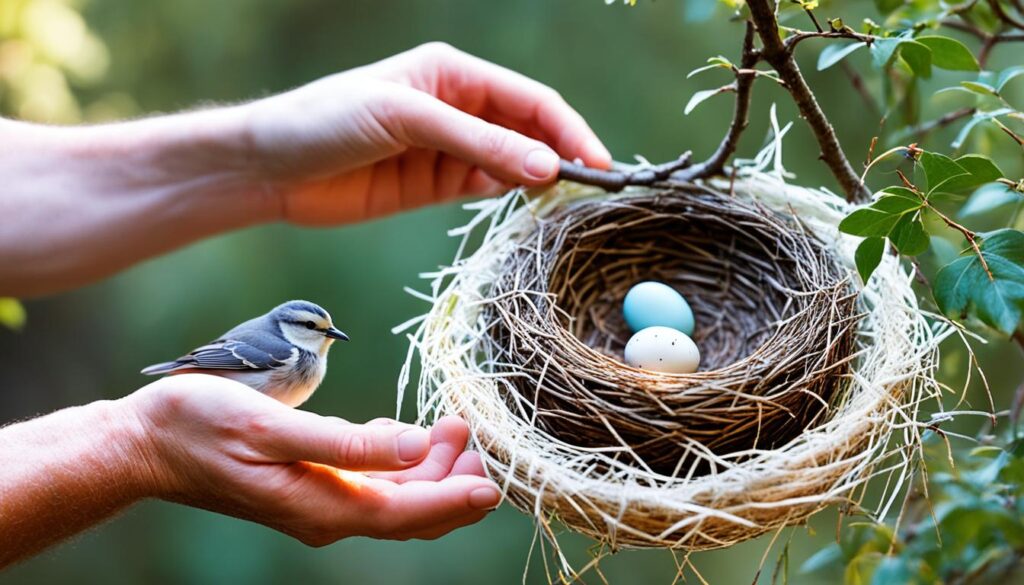

гарантия при продаже аккаунтов купить аккаунт с прокачкой
маркетплейс для реселлеров заработок на аккаунтах
гарантия при продаже аккаунтов магазин аккаунтов социальных сетей
безопасная сделка аккаунтов купить аккаунт
продать аккаунт купить аккаунт
купить аккаунт с прокачкой купить аккаунт
платформа для покупки аккаунтов платформа для покупки аккаунтов
купить аккаунт https://marketplace-akkauntov-top.ru/
заработок на аккаунтах безопасная сделка аккаунтов
площадка для продажи аккаунтов профиль с подписчиками
безопасная сделка аккаунтов https://prodat-akkaunt-online.ru/
профиль с подписчиками аккаунт для рекламы
площадка для продажи аккаунтов магазин аккаунтов
Buy accounts Account Selling Service
Account Selling Service Website for Buying Accounts
Social media account marketplace Buy Account
Sell accounts Account Catalog
Profitable Account Sales Sell accounts
Accounts market Account Acquisition
Account Exchange Service Accounts market
Sell Pre-made Account Buy accounts
Sell accounts Profitable Account Sales
Gaming account marketplace Account Store
Account market https://socialmediaaccountsale.com
account catalog account acquisition
accounts for sale gaming account marketplace
online account store verified accounts for sale
secure account purchasing platform verified accounts for sale
sell pre-made account account buying platform
social media account marketplace account purchase
account market accounts market
website for selling accounts https://accountsmarketdiscount.com
secure account purchasing platform gaming account marketplace
database of accounts for sale guaranteed accounts
sell pre-made account ready-made accounts for sale
account purchase account exchange
account trading platform database of accounts for sale
accounts for sale sell accounts
gaming account marketplace account selling service
account catalog account market
account trading service online account store
buy and sell accounts https://best-social-accounts.org
account trading account buying service
account buying service account purchase
gaming account marketplace https://marketplace-social-accounts.org
purchase ready-made accounts account market
accounts for sale account trading platform
sell account buy and sell accounts
account acquisition https://accounts-store.org/
marketplace for ready-made accounts account exchange service
purchase ready-made accounts account trading platform
account trading service https://top-social-accounts.org
buy account https://accounts-offer.org
gaming account marketplace https://accounts-marketplace.xyz
accounts marketplace buy accounts
account store buy accounts
account purchase account market
account market https://social-accounts-marketplace.xyz
marketplace for ready-made accounts https://buy-accounts.space
find accounts for sale https://buy-accounts-shop.pro/
website for buying accounts https://accounts-marketplace.art
account catalog https://social-accounts-marketplace.live/
account exchange https://buy-accounts.live
account trading platform buy accounts
account trading platform https://accounts-marketplace-best.pro
покупка аккаунтов https://akkaunty-na-prodazhu.pro/
купить аккаунт https://rynok-akkauntov.top
маркетплейс аккаунтов https://kupit-akkaunt.xyz
продажа аккаунтов https://akkaunt-magazin.online/
маркетплейс аккаунтов соцсетей купить аккаунт
покупка аккаунтов https://kupit-akkaunty-market.xyz
покупка аккаунтов https://akkaunty-optom.live
маркетплейс аккаунтов соцсетей https://online-akkaunty-magazin.xyz
купить аккаунт https://akkaunty-dlya-prodazhi.pro/
биржа аккаунтов https://kupit-akkaunt.online/
buy facebook advertising https://buy-adsaccounts.work
buy facebook accounts cheap https://buy-ad-accounts.click
buy facebook accounts for ads buy facebook advertising accounts
buying facebook accounts cheap facebook account
buy facebook ad account buy facebook accounts for ads
buy facebook ad accounts https://buy-ads-account.work
buy facebook account for ads https://ad-account-for-sale.top
buy facebook profiles https://buy-ad-account.click
buy a facebook account https://ad-accounts-for-sale.work/
google ads accounts https://buy-ads-account.top
google ads accounts for sale https://buy-ads-accounts.click
facebook account buy buy facebook accounts for advertising
old google ads account for sale buy google ads accounts
buy google ads invoice account https://ads-account-buy.work
buy google ads accounts https://buy-ads-invoice-account.top
buy google ads account https://buy-account-ads.work
sell google ads account https://buy-ads-agency-account.top
buy google ads https://sell-ads-account.click